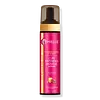What's inside
What's inside
 Key Ingredients
Key Ingredients

 Benefits
Benefits

 Concerns
Concerns

 Ingredients Side-by-side
Ingredients Side-by-side

Water
Skin ConditioningPvp
Emulsion StabilisingPropylene Glycol
HumectantAlcohol Denat.
AntimicrobialOleth-20
CleansingPhenoxyethanol
PreservativeTriethanolamine
BufferingCarbomer
Emulsion StabilisingParfum
MaskingPolyquaternium-11
PEG/PPG-22/24 Dimethicone
EmulsifyingEthylhexylglycerin
Skin ConditioningPentasodium Pentetate
Limonene
PerfumingBenzophenone-4
UV AbsorberHexyl Cinnamal
PerfumingLinalool
PerfumingPEG-70 Mango Glycerides
EmulsifyingButyrospermum Parkii Butter
Skin ConditioningAmyl Cinnamal
PerfumingCeramide AP
Skin ConditioningWater, Pvp, Propylene Glycol, Alcohol Denat., Oleth-20, Phenoxyethanol, Triethanolamine, Carbomer, Parfum, Polyquaternium-11, PEG/PPG-22/24 Dimethicone, Ethylhexylglycerin, Pentasodium Pentetate, Limonene, Benzophenone-4, Hexyl Cinnamal, Linalool, PEG-70 Mango Glycerides, Butyrospermum Parkii Butter, Amyl Cinnamal, Ceramide AP
Water
Skin ConditioningDecyl Glucoside
CleansingPolyquaternium-55
Polysorbate 20
EmulsifyingPvp
Emulsion StabilisingMethyl Gluceth-20
HumectantPhenoxyethanol
PreservativeBenzoic Acid
MaskingEthylhexylglycerin
Skin ConditioningGlycereth-2 Cocoate
EmulsifyingOleth-20
CleansingHoney
HumectantAloe Barbadensis Leaf Juice
Skin ConditioningPunica Granatum Fruit Extract
AntioxidantPunica Granatum Seed Oil
EmollientPyrus Malus Fruit Extract
Skin ConditioningSimmondsia Chinensis Seed Oil
EmollientOrbignya Oleifera Seed Oil
EmollientButyrospermum Parkii Butter
Skin ConditioningSilk Amino Acids
HumectantPanthenol
Skin ConditioningQuaternium-75
Disodium EDTA
Tocopheryl Acetate
AntioxidantCitric Acid
BufferingParfum
MaskingWater, Decyl Glucoside, Polyquaternium-55, Polysorbate 20, Pvp, Methyl Gluceth-20, Phenoxyethanol, Benzoic Acid, Ethylhexylglycerin, Glycereth-2 Cocoate, Oleth-20, Honey, Aloe Barbadensis Leaf Juice, Punica Granatum Fruit Extract, Punica Granatum Seed Oil, Pyrus Malus Fruit Extract, Simmondsia Chinensis Seed Oil, Orbignya Oleifera Seed Oil, Butyrospermum Parkii Butter, Silk Amino Acids, Panthenol, Quaternium-75, Disodium EDTA, Tocopheryl Acetate, Citric Acid, Parfum
Ingredients Explained
These ingredients are found in both products.
Ingredients higher up in an ingredient list are typically present in a larger amount.
This ingredient is also known as shea butter. It is an effective skin hydrator and emollient.
Emollients help soothe and soften your skin. It does this by creating a protective film on your skin. This barrier helps trap moisture and keeps your skin hydrated. Emollients may be effective at treating dry or itchy skin.
Shea butter is rich in antioxidants. Antioxidants help fight free-radicals, or molecules that may harm the body. It is also full of fatty acids including stearic acid and linoleic acid. These acids help replenish the skin and keep skin moisturized.
While Shea Butter has an SPF rating of about 3-4, it is not a sunscreen replacement.
Shea butter may not be fungal acne safe. We recommend speaking with a professional if you have any concerns.
Learn more about Butyrospermum Parkii ButterEthylhexylglycerin (we can't pronounce this either) is commonly used as a preservative and skin softener. It is derived from glyceryl.
You might see Ethylhexylglycerin often paired with other preservatives such as phenoxyethanol. Ethylhexylglycerin has been found to increase the effectiveness of these other preservatives.
Oleth-20 comes from oleyl alcohol. It is an emulsifier that helps reduce surface tension of dirt and pollutants to be washed away.
The 20 stands for the average number of ethylene oxide units.
Parfum is a catch-all term for an ingredient or more that is used to give a scent to products.
Also called "fragrance", this ingredient can be a blend of hundreds of chemicals or plant oils. This means every product with "fragrance" or "parfum" in the ingredients list is a different mixture.
For instance, Habanolide is a proprietary trade name for a specific aroma chemical. When used as a fragrance ingredient in cosmetics, most aroma chemicals fall under the broad labeling category of “FRAGRANCE” or “PARFUM” according to EU and US regulations.
The term 'parfum' or 'fragrance' is not regulated in many countries. In many cases, it is up to the brand to define this term.
For instance, many brands choose to label themselves as "fragrance-free" because they are not using synthetic fragrances. However, their products may still contain ingredients such as essential oils that are considered a fragrance by INCI standards.
One example is Calendula flower extract. Calendula is an essential oil that still imparts a scent or 'fragrance'.
Depending on the blend, the ingredients in the mixture can cause allergies and sensitivities on the skin. Some ingredients that are known EU allergens include linalool and citronellol.
Parfum can also be used to mask or cover an unpleasant scent.
The bottom line is: not all fragrances/parfum/ingredients are created equally. If you are worried about fragrances, we recommend taking a closer look at an ingredient. And of course, we always recommend speaking with a professional.
Learn more about ParfumPhenoxyethanol is a preservative that has germicide, antimicrobial, and aromatic properties. Studies show that phenoxyethanol can prevent microbial growth. By itself, it has a scent that is similar to that of a rose.
It's often used in formulations along with Caprylyl Glycol to preserve the shelf life of products.
Pvp is a water-soluble synthetic polymer and common hairstyling ingredient. It is a film-forming ingredient and used to "hold" specific shapes of hair.
Pvp is less effective in high-humidity. It tends to draw moisture, but this moisture dismantles the structure and "hold".
Water. It's the most common cosmetic ingredient of all. You'll usually see it at the top of ingredient lists, meaning that it makes up the largest part of the product.
So why is it so popular? Water most often acts as a solvent - this means that it helps dissolve other ingredients into the formulation.
You'll also recognize water as that liquid we all need to stay alive. If you see this, drink a glass of water. Stay hydrated!
Learn more about Water